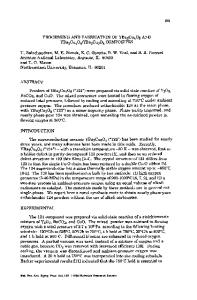Optical and electrical properties of Cu 2 O, Cu 4 O 3 and CuO
- PDF / 602,505 Bytes
- 5 Pages / 612 x 792 pts (letter) Page_size
- 117 Downloads / 433 Views
Optical and electrical properties of Cu2O, Cu4O3 and CuO Daniel Reppin1, Angelika Polity1, Bruno K. Meyer1, and Sviatoslav Shokhovets2 1 Institute of Experimental Physics I, Justus-Liebig-University, Heinrich-Buff-Ring 16, 35392 Giessen, Germany 2 Institute of Physics, Ilmenau University of Technology, Weimarer Strasse 32, 98693 Ilmenau, Germany ABSTRACT We deposited copper oxides by rf magnetron sputtering from a 4N Cu-target at room temperature, varying the oxygen flux and keeping the argon flow constant. Dependent on the oxygen flux Cu2O, Cu4O3 or CuO were synthesized. The different compounds were characterized by XRD. The dielectric functions of the oxides were determined by spectroscopic ellipsometry and show significant differences between the compounds. The electrical properties, like the carrier concentration, of each compound can be tuned by adjusting the oxygen flux. We discuss the structural, optical and electrical properties of the copper oxides in terms of phase purity and stoichiometry deviations. INTRODUCTION With the band gaps ranging from 1.4 eV (CuO) to 2.2 eV (Cu2O) and with the intrinsic ptype conductivity the copper oxides are interesting materials for a wide range of applications like thin film transistors or photovoltaic devices. Thus in the last years copper oxides gained a renewed interest of the research community due to their semiconducting properties and sustainability. The system of copper oxides comprises the phases cuprite (Cu2O), paramelaconite (Cu4O3) and tenorite (CuO) [1–5]. Whereas the optical properties of Cu2O are well known this does not apply for the other two compounds. Especially for Cu4O3, the published band gap energies range from 1.3 to 2.5 eV [3,6–8]. The non-stoichiometry of the copper oxides may also be useful in other applications like oxygen storage [9,10]. We investigated the properties of the three different compounds Cu2O, Cu4O3 and CuO by XRD, Hall and spectroscopic ellipsometry (SE) measurements. EXPERIMENT The copper oxides were deposited on soda lime glass by rf magnetron sputtering technique from a copper target of 4N purity. The base pressure of the chamber was 5·10-6 Pa for all depositions; the sputtering pressure was around 4.8·10-1 Pa, depending on the oxygen flux. Sputtering power was kept constant at 75 W, the argon flux was 35 sccm and the oxygen flux was varied in 0.1 sccm steps. The deposition time was 10 minutes and the expected substrate temperature is below 100 °C. The crystallographic properties were measured using a Siemens D5000 diffractometer. Electrical properties were determined by Hall effect measurements. A Perkin Elmer Lambda 900 spectrometer was used for measuring the transmission and reflection spectra. The complex dielectric function was measured with a rotating analyzer Woollam VASE ellipsometer with an autoretarder.
EXPERIMENTAL RESULTS AND DISCUSSION By varying the oxygen flux in the sputter process in the range of 3.0 to 8.0 sccm, it is possible to synthesize all three copper oxides. Figure 1 shows the diffractograms of represent
Data Loading...











